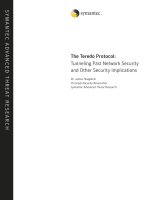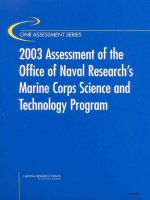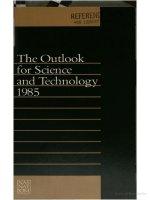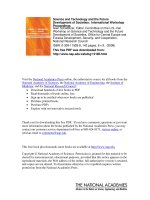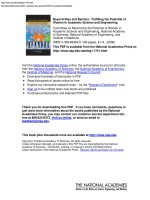The Geek Atlas: 128 Places Where Science and Technology Come Alive pptx
Bạn đang xem bản rút gọn của tài liệu. Xem và tải ngay bản đầy đủ của tài liệu tại đây (24.76 MB, 544 trang )
Beijing · Cambridge · Farnham · Köln · Sebastopol · Taipei · Tokyo
GA_Title.pdf 5/1/09 9:50:51 AM
GA_Title.pdf 5/1/09 9:50:51 AM
The Geek Atlas: 128 Places Where Science & Technology Come Alive
by John Graham-Cumming
Copyright © 2009 John Graham-Cumming. All rights reserved.
Printed in the United States of America.
Published by O’Reilly Media, Inc., 1005 Gravenstein Highway North, Sebastopol, CA
95472.
O’Reilly books may be purchased for educational, business, or sales promotional use.
Online editions are also available for most titles (my.safaribooksonline.com). For more
information, contact our corporate/institutional sales department: (800) 998-9938 or
Editor:
Julie Steele
Production Editor:
Rachel Monaghan
Production Services:
Newgen North America
Copyeditor:
Emily Quill
Proofreader:
Rachel Monaghan
Indexer:
Julie Hawks
Cover Designer:
Monica Kamsvaag
Interior Designer:
Ron Bilodeau
Illustrator:
Robert Romano
Printing History:
May 2009: First Edition.
Nutshell Handbook, the Nutshell Handbook logo, and the O’Reilly logo are registered
trademarks of O’Reilly Media, Inc. The Geek Atlas, the cover image, and related trade
dress are trademarks of O’Reilly Media, Inc.
The image of the AbioCor Total Artificial Heart on the cover is used courtesy of the
Smithsonian Institution, National Museum of American History.
Many of the designations used by manufacturers and sellers to distinguish their prod-
ucts are claimed as trademarks. Where those designations appear in this book, and
O’Reilly Media, Inc. was aware of a trademark claim, the designations have been printed
in caps or initial caps.
While every precaution has been taken in the preparation of this book, the publisher
and author assume no responsibility for errors or omissions, or for damages resulting
from the use of the information contained herein.
TM
This book uses Repkover,™ a durable and flexible lay-flat binding.
ISBN: 978-0-596-52320-6
[M]
iii
Contents
000
Introduction xi
Australia
001
Parkes Radio Telescope, Parkes, Australia 1
Austria
002
Zentralfriedhof, Vienna, Austria 5
Belgium
003
Atomium, Brussels, Belgium 8
Canada
004
Baddeck, Nova Scotia, Canada 12
Czech Republic
005
Mendel Museum of Genetics, Brno, Czech Republic 15
Ecuador
006
Galápagos Islands, Ecuador 19
France
007
Airbus, Toulouse, France 23
008
The Arago Medallions, Paris, France 26
009
Beaumont-de-Lomagne, France 31
010
Château du Clos Lucé, Amboise, France 34
011
Institut Pasteur, Paris, France 37
012
The Jacquard Museum, Roubaix, France 40
iv
|
The Geek Atlas
013
Le Panthéon, Paris, France 43
014
Millau Viaduct, Millau, France 47
015
Musée Curie, Paris, France 50
016
Musée de l’Air et de l’Espace, Le Bourget, France 54
017
Musée des Arts et Métiers, Paris, France 58
018
The Eiffel Tower, Paris, France 62
Germany
019
Deutsches Museum, Munich, Germany 65
020
Peenemünde Historical Technical Information Center,
Peenemünde, Germany 70
021
Röntgen Museum, Remscheid, Germany 74
022
Stadtfriedhof, Göttingen, Germany 78
023
The Gutenberg Museum, Mainz, Germany 83
India
024
Jantar Mantar, Jaipur, India 87
Ireland
025
Broom Bridge, Dublin, Ireland 91
Italy
026
Tempio Voltiano, Como, Italy 95
Japan
027
Akashi-Kaikyo Bridge, Kobe, Japan 98
028
Akihabara, Tokyo, Japan 102
Netherlands
029
The Escher Museum, The Hague, Netherlands 105
Serbia
030
Tesla Museum, Belgrade, Serbia 108
Contents
|
v
Spain
031
Solúcar PS10 Power Station, Sanlúcar la Mayor, Spain 112
Switzerland
032
CERN, Geneva, Switzerland 116
033
Historisches Museum Bern, Bern, Switzerland 120
Taiwan
034
Taipei 101, Taipei, Taiwan 124
UK
035
14 India Street, Edinburgh, Scotland 128
036
Air Defence Radar Museum, RAF Neatishead, England 133
037
Albury Church, Albury, England 137
038
Alexander Fleming Laboratory Museum, London, England 142
039
Anderton Boat Lift, Northwich, England 145
040
Bletchley Park, Bletchley, England 148
041
British Airways Flight Training, Hounslow, England 153
042
Bunhill Fields Cemetery, London, England 158
043
Down House, Downe, England 162
044
Edward Jenner Museum, Berkeley, England 165
045
Elsecar Heritage Centre, Elsecar, England 168
046
Farnborough Air Sciences Museum, Farnborough, England 171
047
Gonville and Caius College, Cambridge, England 175
048
Goonhilly Satellite Earth Station, Goonhilly, England 181
049
Greenwich, London, England 185
050
Hovercraft Museum, Lee-on-the-Solent, England 188
051
Jodrell Bank Observatory, Cheshire, England 191
052
Kelvedon Hatch Nuclear Bunker, Kelvedon Hatch, England 195
053
Kempton Park Waterworks, Kempton Park, England 199
054
Lacock Abbey, Wiltshire, England 202
055
Manchester Science Walk, Manchester, England 206
056
Museum of the History of Science, Oxford, England 209
057
Napier University, Edinburgh, Scotland 212
vi
|
The Geek Atlas
058
National Museum of Computing, Bletchley, England 216
059
National Museum of Scotland, Edinburgh, Scotland 220
060
National Railway Museum, York, England 223
061
Natural History Museum, London, England 227
062
Poldhu, Cornwall, England 231
063
Porthcurno Telegraph Museum, Porthcurno, England 235
064
Royal College of Surgeons Hunterian Museum,
London, England 239
065
Royal Gunpowder Mills, Waltham Abbey, England 243
066
Sackville Street Gardens, Manchester, England 247
067
Sound Mirrors, Dungeness, England 251
068
SS Great Britain, Bristol, England 255
069
The Apple Tree, Trinity College, Cambridge, England 259
070
The Brunel Museum, London, England 264
071
The Eagle Pub, Cambridge, England 267
072
The Falkirk Wheel, Falkirk, Scotland 271
073
The Hunterian Museum, Glasgow, Scotland 275
074
The Iron Bridge, Ironbridge, England 280
075
The Royal Institution of Great Britain, London, England 283
076
The Science Museum, Swindon, England 288
077
The Science Museum, London, England 292
078
Thinktank, Birmingham, England 297
079
Westminster Abbey, London, England 302
Ukraine
080
Chernobyl Exclusion Zone, Ukraine 307
U.S.
Alaska
081
Aurora Borealis, Fairbanks, AK 310
082
Trans-Alaska Pipeline Visitor Center, Fox, AK 315
Arizona
083
Titan Missile Museum, Sahuarita, AZ 319
Contents
|
vii
California
084
391 San Antonio Road, Mountain View, CA 323
085
844 E. Charleston Road, Palo Alto, CA 327
086
The Computer History Museum, Mountain View, CA 331
087
Goldstone Deep Space Communications Complex,
Fort Irwin, CA 337
088
Joint Genome Institute, Walnut Creek, CA 342
089
1 Infinite Loop, Cupertino, CA 346
090
The HP Garage, Palo Alto, CA 350
Connecticut
091
U.S. Navy Submarine Force Museum, Groton, CT 354
District of Columbia
092
National Air and Space Museum, Washington, DC 358
093
National Museum of American History, Washington, DC 362
Florida
094
Kennedy Space Center, Merritt Island, FL 366
Hawaii
095
Kalaupapa National Historic Park, Molokai, HI 370
Idaho
096
Experimental Breeder Reactor No. 1, Arco, ID 374
Illinois
097
Fermilab, Batavia, IL 379
Massachusetts
098
MIT Museum, Cambridge, MA 383
Maryland
099
Gaithersburg International Latitude Observatory,
Gaithersburg, MD 387
100
National Electronics Museum, Linthicum, MD 391
101
National Cryptologic Museum, Fort Meade, MD 395
Michigan
102
The Henry Ford, Dearborn, MI 401
viii
|
The Geek Atlas
Missouri
103
Gateway Arch, St. Louis, MO 406
New Jersey
104
Horn Antenna, Holmdel, NJ 411
105
Institute for Advanced Study, Princeton, NJ 414
New Mexico
106
Trinity Test Site, White Sands Missile Range, NM 418
107
Very Large Array, Socorro, NM 422
108
White Sands Missile Range Museum,
White Sands Missile Range, NM 426
Nevada
109
Atomic Testing Museum, Las Vegas, NV 430
110
Nevada Test Site, NV 433
111
Zero G, Las Vegas, NV 438
New York
112
Glenn H. Curtiss Museum, Hammondsport, NY 441
113
John M. Mossman Lock Collection, New York, NY 444
114
Sagan Planet Walk, Ithaca, NY 446
Ohio
115
Early Television Museum, Hillard, OH 450
116
NASA Glenn Research Center, Cleveland, OH 453
Oregon
117
Evergreen Aviation & Space Museum, McMinnville, OR 457
Pennsylvania
118
Joseph Priestley House, Northumberland, PA 460
Puerto Rico
119
Arecibo Observatory, Arecibo, Puerto Rico 464
Tennessee
120
X-10 Graphite Reactor, Oak Ridge, TN 468
Contents
|
ix
Virginia
121
Kryptos Sculpture, Langley, VA 472
122
Shot Tower Historical State Park, Austinville, VA 477
Washington
123
American Museum of Radio and Electricity, Bellingham, WA . . 481
124
Grand Coulee Dam, Coulee Dam, WA 485
West Virginia
125
Reber Radio Telescope, Green Bank, WV 489
126
The Greenbrier, White Sulphur Springs, WV 493
Miscellaneous
127
Magicicada Brood X, East Coast, U.S. 497
128
Magnetic North Pole 501
Index
507
xi
000
Introduction
A Mind Forever Voyaging
For my 13th birthday my parents took me around Dove Cottage, former home
of the English poet William Wordsworth. I remember only one thing from that
visit—an underground stream that kept one of the rooms cool, making it ideal
storage for food. There in Wordsworth’s house was a little bit of science waiting
to be discovered.
Unfortunately, finding great scientific places to visit isn’t as easy as finding the
homes of long-dead poets, painters, or writers. Call any tourist office around the
world and ask about scientific, mathematical, or technological attractions, and
you’ll be greeted with either a long silence or a short list of the obvious famous
science museums. This is a pity, because if there’s one thing that makes science
stand apart, it’s the willingness of scientists to freely share what they do. And the
world is full of wonderful sites, museums, and seemingly random places that
make the geek heart pound a little harder. Many of them are even free of charge.
This book’s 128 places is a personal list of sites to visit where science, math-
ematics, or technology happened or is happening. You won’t find tedious little
third-rate museums, or plaques stuck to the wall stating that “Professor X slept
here” among the selections. Every place has real scientific, mathematical, or
technological interest.
Not all of the places feature man-made inventions or discoveries. There are also
natural phenomena such as the moving Magnetic North Pole (Chapter 128)
and the Aurora Borealis (Chapter 81). And there are a few graves of famous sci-
entists, but rest assured that those graves have equations on them.
Each place has its own chapter, and each chapter is split into three parts: a gen-
eral introduction to the place with an emphasis on its scientific, mathematical,
or technological significance; a related technical subject covered in more detail;
and practical visiting information. The book can be used as a true travel guide
(and I hope you have the opportunity to visit some of the places), but it is also
xii
|
The Geek Atlas
for the armchair traveler, whom I hope is inspired to put the book down and
learn more about the science, mathematics, and technology covered.
In the technical descriptions, I’ve tried to simplify the science without dumb-
ing it down to the point of using analogies and metaphors instead of actually
describing the ideas. So as you flip through the book, you’ll see the sorts of
pictures you’d find in a travel guide, but also a lot of diagrams and equations.
(Any reader who doesn’t want to deal with the equations can safely read the
first part of each chapter.)
There’s also quite a bit of abstract mathematics covering topics like set theory,
transfinite numbers, Fermat’s Last Theorem, prime numbers, group theory, and
more. To non-mathematicians these topics may be off-putting, but I suggest
you stick with them. I promise that when you understand Cantor’s diagonaliza-
tion argument (page180) showing the existence of different magnitudes of in-
finity, a whole world of pure mathematical beauty will be revealed. (Yes, I admit
it—I’m a mathematics nerd.)
One thing that I’ve been asked by reviewers again and again is to recommend
one single must-see place. Picking one place is next to impossible—there’s just
so much great science out there—but I will admit to shedding a tear every time
I see the Difference Engine at the Science Museum in London (Chapter 77). It’s
mathematics in motion and arithmetic in action.
A disappointing trend with science museums today is a tendency to emphasize
the “Wow!” factor without really explaining the underlying science. If it appears
that I’ve overlooked your favorite museum, ask yourself whether it has any of the
following annoying attributes: a short name ending with an exclamation mark,
a logo featuring pastel colors or a cuddly cartoon mascot, or an IMAX theater.
Believe me, there’s more real “Wow!” in understanding Foucault’s measurement
of the speed of light (page 60) than in any movie, no matter how big it is.
A number of places do not appear in this book because tours have ended or
been severely curtailed on account of “security concerns.” This applies almost
exclusively to the United States, where some interesting places for scientific
tourism are now considered too sensitive for the general public. Other places
have restricted access to U.S. citizens only (which is ironic, given the contri-
bution of non-Americans to U.S. scientific research); some of these have been
included in the hope that citizenship restrictions will be lifted in the coming
years.
Introduction
|
xiii
If your favorite scientist is missing, it may simply be because there’s no single
place that sums up his or her work. For example, I was hoping to include rocket-
ry pioneer Robert Goddard, but none of the possible places is really suitable—
the Goddard Rocket Launching Site in Massachusetts is just a historic marker
in the middle of a golf course; the Goddard Space Flight Center in Maryland is
great, but there are only so many NASA sites this book could hold; and the Ro-
swell Museum in New Mexico bills itself more as an art museum than anything
else. Nevertheless, of the three, the Roswell Museum is the best—it does, after
all, have most of Goddard’s equipment on display.
Other places almost made the cut, but weren’t quite up to scratch. I wanted to
include the Florence Nightingale Museum in London, because Nightingale’s
contribution to using graphics to illustrate quantitative information is largely
overlooked. She was the first woman to become a member of the Royal Statisti-
cal Society, and her diagrams of the causes of death at a military field hospital
are on display at the museum. Unfortunately, the display is a poor reproduc-
tion that provides no real information about what the visitor is seeing or about
Nightingale’s contribution to the use of graphics (including pie charts).
If you’re still asking yourself why your favorite place isn’t covered, please visit
the book’s accompanying website and tell me about it. I’m probably not aware
of it and would love to go and visit. Who knows, there might be enough good
ideas for a second edition!
jgc —
May 2009
P.S. As it turns out, I probably should have paid more attention at Dove Cottage.
Years later I discovered that Wordsworth was an admirer of Newton, and wrote
the following lines inspired by Newton’s statue at Trinity College, Cambridge:
The antechapel where the statue stood
Of Newton with his prism and silent face,
The marble index of a Mind for ever
Voyaging through strange seas of Thought, alone.
xiv
Conventions Used in This Book
Throughout this book I’ve used metric units. Since the book covers a mixture of
countries, such as the U.S., which uses its own mixture of Imperial and custom-
ary units; France, which uses metric; and the U.K., which uses a hodgepodge of
Imperial and metric, I decided to take the scientific option and go metric. This
also avoids problems like the difference in volume between a U.S. gallon and
an Imperial gallon.
Metric units may feel a little peculiar to American readers since I speak about
distance between places in the U.S. in kilometers. To make up for that, despite
being British, I use U.S. spelling throughout.
For place names, I’ve opted for the format Place Name, Nearest Village/City/Town,
Country for everywhere but the U.S. Within the U.S., the format is Place Name,
Nearest City/Town, State. I use two-letter U.S. state abbreviations. Non-American
readers who are unsure which of MI, MO, and MS is Missouri can check in with the
U.S. Postal Service at />Each place in the book has a Practical Information section that typically gives
the address of the associated website if there is one, and directions if not. In ad-
dition, every place has its latitude and longitude listed, ready for use with a GPS
navigation device or an online mapping service.
A quick visual reference at the start of each chapter gives some basic practical
information; the following four icons are used:
Entry to this place is free.
Refreshments are available on site.
This place is suitable for children.
This place can be visited in any kind of weather.
But please remember that things change. A previously free attraction may start
charging a fee, a restaurant may close, or access to the site may be restricted.
Check with the place before visiting; if things have changed, please let me
know so that future editions of this book can be updated.
xv
We’d Like to Hear from You
We have verified the information in this book to the best of our ability, but you
may find that features have changed or that we may have made a mistake or
two (shocking and hard to believe). Please let us know about any errors you
find, as well as your suggestions for future editions by writing to:
O’Reilly Media, Inc.
1005 Gravenstein Highway North
Sebastopol, CA 95472
800-998-9938 (in the United States or Canada)
707-829-0515 (international or local)
707-829-0104 (fax)
We have a web page for this book where we list examples and any plans for
future editions. You can access this information at:
/>You can also send messages electronically. To be put on the mailing list or re-
quest a catalog, send an email to:
To comment on the book, send an email to:
For more information about our books, conferences, Resource Centers, and the
O’Reilly Network, see our website at:
Safari® Books Online
When you see a Safari® Books Online icon on the cover of
your favorite technology book, that means the book is avail-
able online through the O’Reilly Network Safari Bookshelf.
Safari offers a solution that’s better than e-books. It’s a virtual library that lets
you easily search thousands of top tech books, cut and paste code samples,
download chapters, and find quick answers when you need the most accurate,
current information. Try it for free at .
1
001
Parkes Radio Telescope,
Parkes, Australia
32° 59
′
59.8
″
S, 148° 15
′
44.3
″
E
The Dish
If you find yourself in the land down under (or just happen to be lucky enough
to live there), then there’s one landmark that shouldn’t be missed, because it’s
the star of a movie that is all about science. The film is The Dish, and its star is the
Parkes Radio Telescope (Figure 1-1).
The Dish; courtesy of Alex Cheal (alexcheal) Figure 1-1.
Halfway between Melbourne and Brisbane, and 20 kilometers north of the
small town of Parkes, stands the gracefully curved dish that since 1961 has been
listening to the southern sky for radio transmissions.
2
|
The Geek Atlas
Pulsars
(The Original Little Green Men)
In July 1967, a team at Cambridge University was working on a radio telescope
to listen to signals from quasars (radio sources coming from somewhere in the
sky). But they discovered something strange—a pulsating radio signal from
the heavens that lasted 40 milliseconds and repeated regularly every 1.337
seconds. At first they thought it must be noise from some earthly source, but
quickly realized it was not and named the source LGM-1 (Little Green Men-1).
What they had discovered was a pulsar (or pulsating star), but having never
heard a radio source of such regularity coming from the sky, they speculated
that it might be a message from a distant civilization, or a navigational bea-
con for some unknown beings traveling the universe.
Today, LGM-1 is known as the pulsar CP1919, and is one of more than 1,000
known pulsars. And pulsars have been discovered that emit more than just
radio waves—they also eject regular bursts of X-rays and gamma rays.
Pulsars are created by rapidly rotating neutron stars. A neutron star is created
when a star undergoes a supernova, running out of energy and suddenly
collapsing in on itself because of its own gravity. This results in an incredibly
dense and compact corpse of a star: a neutron star.
Neutron stars are typically less than 20 kilometers across (the distance from
the town of Parkes to the telescope), but contain more mass than the Sun.
The interior of a neutron star is made up of neutrons, because the incredible
pressure in the star has forced protons and electrons together, eliminating
any charge. Deep inside the neutron star, the pressure is so great that there’s
probably a soup of even more fundamental particles such as quarks.
Neutron stars are prevented from completely collapsing by the Pauli Exclu-
sion Principle, which says that no two neutrons (in fact, no two identical
fermions: see page 118) can occupy the same place at the same time.
It is believed that as the neutron star rotates, its magnetic field interacts with
charged particles, leaving its surface to generate electromagnetic radia-
tion. The radiation may be in the radio spectrum or in the form of gamma
or X-rays. It leaves the star in a continuous beam emanating from the star’s
magnetic north and south poles. This is illustrated in Figure 1-2.
Parkes Radio Telescope, Parkes, Australia
|
3
A pulsar with its magnetic field and beams of radiationFigure 1-2.
Since the star’s rotational poles and magnetic poles are offset, the beam isn’t
continuously pointed at the Earth, and only sweeps the Earth (appearing to
us as a pulse) once per rotation.
In truth, much about pulsars is still not understood, even after 40 years of
listening to them. Perhaps the Cambridge University team’s LGM-1 designa-
tion was correct after all, and Parkes has been missing extraterrestrial “g’days”
since it opened in1961.
4
|
The Geek Atlas
It was the Parkes Radio Telescope’s role in picking up transmissions from the
Apollo 11 moon landing that made it a movie star. When Neil Armstrong and
Buzz Aldrin landed on the moon on July 20, 1969, their transmission of telem-
etry and television pictures was initially sent to the Goldstone Observatory in
the Mojave Desert in California. But problems developed, and NASA switched
to getting the signals from the Honeysuckle Creek receiver near Canberra in
Australia. Shortly thereafter, they switched to Parkes and found the signal so
good that they stuck with the Dish for the rest of the transmission.
The Dish has been involved in a number of other space missions, including
Voyager 2 (when it passed close to Uranus and Neptune and returned images
of the planets); the Giotto probe that flew close to Halley’s Comet in 1986; and
the Galileo probe, which photographed Jupiter in 1997.
The Dish has a small visitor center and two small cinemas showing films ex-
plaining radio astronomy and the solar system. While the visitor center is free,
there’s a small fee for the cinemas. Since the Dish is located far from civilization,
there’s a café serving drinks and meals, and also free picnic facilities and bar-
beque equipment.
Unfortunately for visitors, the Dish itself is in constant use and is not open for
tours. But the observatory occasionally hosts open days when the general
public can climb up into the Dish’s rotating mounting, and afterward attend a
talk by one of the telescope’s scientists. In the past, the open days have been
rounded out by a screening of The Dish under the starlit sky.
As you approach the Dish, switch off anything with a radio in it (such as a mo-
bile phone)—the Dish is listening for very faint radio signals from across the
cosmos, so it doesn’t need to listen to you nattering away. Since Parkes is a
bit remote, consider making the trip to coincide with a major local event: the
Parkes Elvis Festival (held annually in the second week of January) is not to be
missed.
But the 64-meter-wide Dish’s main job is radio astronomy, with a special em-
phasis on pulsars (see sidebar). Over the years, the Dish has been upgraded to
make it more and more sensitive to the incredibly faint signals that reach the
Earth’s surface.
Practical Information
Information about the Parkes Radio Telescope and other Australian observato-
ries is available from />5
002
Zentralfriedhof,
Vienna, Austria
48° 8
′
58
″
N, 16° 26
′
28
″
E
A Scientist Among the Composers
If you need an excuse to visit the beautiful Austrian capital, then use the Zentral-
friedhof (Central Cemetery) as your reason. Although the cemetery may not be
one of the most famous attractions in Austria, it is the final resting place of
many celebrated Austrians (and others), including Beethoven, Brahms, Schu-
bert, four Strausses, and a host of other artists and politicians. But the grave
that’s waiting for scientific visitors is the one with a fundamental equation of
thermodynamics written upon it.
That grave belongs to Ludwig Boltzmann, the Austrian physicist who created
statistical mechanics (which helps to explain how the fundamental proper-
ties of atoms, such as mass or charge, determine the properties of matter) and
showed that the laws of mechanics at an atomic level could explain the second
law of thermodynamics (roughly that heat cannot flow from a cool body to a
hotter body) via Boltzmann’s Equation (see Equation 2-1).
Boltzmann’s EquationEquation 2-1.
Boltzmann lived during the 19th century (he died just after the turn of the
20th) and firmly believed that matter was composed of atoms and molecules.
Despite the fact that Dalton (see Chapter 55) had described atomic weights
in 1808, there was still debate about the existence of atoms. But Boltzmann
used what others considered to be an unproven theory to apply, to great effect,
probability theory to the physical world through statistical mechanics.
Along with James Clerk Maxwell (see Chapter 35) and Josiah Willard Gibbs,
Boltzmann was one of the most important physicists of the 19th century. His
grave (Figure 2-1) is a testament to his importance, with his famous equation
cut into the stone and featuring an imposing bust of the scientist. He is buried
alongside members of his family.
6
|
The Geek Atlas
Boltzmann’s grave; courtesy of Martin Röll (martinroell)Figure 2-1.
The cemetery itself is enormous—2.4 square kilometers in size with around
three million people buried there, making it one of the largest cemeteries in
Europe. One area contains the tombs of notables, of which Boltzmann is the
only scientist.
While you are in Vienna, there’s also a small museum in Freud’s former home
that is worth a visit.
Practical Information
The number 71 tram has multiple stops at the Zentralfriedhof. Boltzmann’s
grave is in section 14C of the cemetery, which is closest to the Zentralfriedhof
Tor 2 stop.
Zentralfriedhof, Vienna, Austria
|
7
Statistical Mechanics and Entropy
The relationship between the macrostates (such as volume, temperature, and
pressure) and the microstates (the location, mass, and velocity of individual at-
oms) of a material is fundamental to statistical mechanics, and Boltzmann laid
its foundations. The macrostates are easily measured; the microstates are not.
Externally, a bottle full of air might be described by a small number of macro-
states—its exact volume, temperature, and pressure could be measured, for
example. But inside the air, the molecules are moving around and bumping
into each other, and for any fixed macrostates the microstates are constantly
changing. Nevertheless, there’s a relationship between the micro and macro.
Boltzmann’s entropy can be thought of as a measure of the degree of chaos
inside the bottle, or a measure of the number of different ways the molecules
of air can arrange themselves to achieve the same volume, pressure, and
temperature.
Imagine a pack of 52 playing cards dropped on the floor. You can think of
them as having one macrostate: the number of playing cards that are face
up. That macrostate, like volume, temperature, and pressure, can be easily
measured. But for any specific number of face-up cards, there are many dif-
ferent combinations of individual face-up cards: that is, for any macrostate
there are many possible microstates (each card has its own microstate speci-
fying whether it is up or down).
If all the cards are face up, then there’s little chaos: each card’s microstate is
known. The same applies if all are face down. The most chaos occurs at the
midpoint of these two extremes: when 26 cards are face up and 26 cards are
face down. Then there are 495,918,532,948,104 possible microstates.
Boltzmann’s famous equation (as interpreted by Max Planck) uses the num-
ber of possible microstates, W, for any given set of macrostates. The constant
k is known as Boltzmann’s constant. The resulting value, S, the entropy, is
actually a macrostate just like volume, temperature, or pressure and can be
calculated for an ideal gas (for more on ideal gases, see page 211).
For any given volume, temperature, and pressure, the entropy, S, is a measure
of how uncertain we are about the internal state of the gas.
Boltzmann’s equation is engraved on his tomb because it is the fundamen-
tal link between the microscopic world of moving, colliding atoms and the
macroscopic world of temperatures, pressures, and volumes.

